By Karen Moyer
On February 7, thirty members of the CVSC ventured to Japan this month for 10 days of travel, skiing, site seeing, and cultural experience. The trip was arranged by Trip Leaders Judi and Larry Fordyce who coordinated everything through Holidaze and Ski Japan; the planning and execution of the trip was impeccable. The entire group had a wonderful experience, including the people who did not ski. There was literally something for everyone on this trip!
Perspective
Japan is roughly the size of California, and has over 500 ski area throughout the country. (Compared to 476 ski areas operating throughout the United States during the 2018/2019 season.) The Japan Alps is a series of mountain ranges on the main is- land of Japan and cross 7 prefectures. Prefectures are similar to our states; Japan has 43 prefectures which are geographic.
There are about 100 ski areas in the Nagano Prefecture in the northern alps; we stayed in Hakuba, an area where there were 10 resorts a short distance from the hotel. Hakuba is about 45 minutes from Nagano.
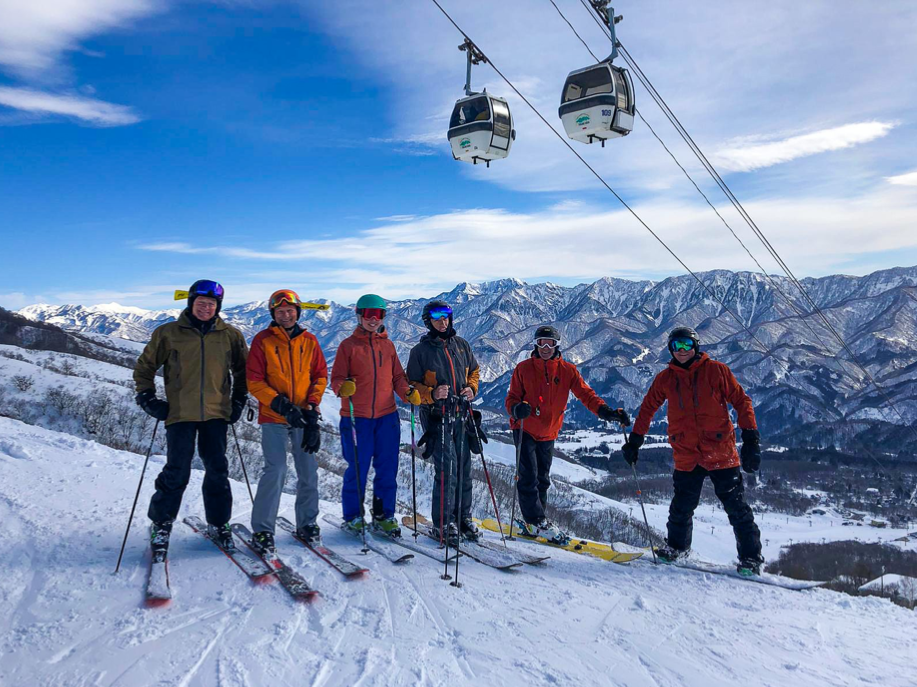
Nagano hosted the 1998 Olympics. The Alpine Combined, Cross Country Skiing, Nordic Combined, Ski Jumping and Downhill Super-G were hosted on the mountains we skied. Other Olympic events took place in Nagano and other ski areas we could see in a distance from Nagano.
The travel time to get to Hakuba was about 24 hours. The group left Cleveland early to fly to Detroit, from there, our flight to Tokyo-Narita, Japan was over 13 hours. After gathering up our luggage, the bus ride to Hakuba was 6 more hours, which included a dinner stop along the way.
The return trip was through Atlanta, an 11.5 hour flight from Tokyo-Narita and then about 2 more hours back to Cleveland. On the way back we took the bullet train from Nagano into Tokyo where we spent 3 days/2 nights site seeing in the biggest city in Japan.
The time difference between Cleveland and Japan is 14 hours. Japan is over a half day ahead of us in the eastern time zone.
Skiing
The weather allowed us to ski in every ski condition in the week we were in Hakuba. We had 2 days of snowing and powder, 2 days of blue skies and groomed trails, and 1 day of spring ski conditions after the weather warmed up at the end of the week. Most people skied either 4 or 5 days.
We were able to ski 10 areas, catching various busses from the front of our hotel, the Hakuba Mominoki Hotel. Lift tickets were valid at all 10 areas and you could easily ski more than one area in a day. Most rented skis from the Rhythm Beats ski shop across the parking lot. Lift tickets were purchased at the hotel for those who did not have an Epic pass.
I’d compare the size of each area to Holiday Valley, but with much higher elevation and longer runs.
Happo One, the ski area closest to our hotel, has a peak elevation of 6000’, with a 3518’ vertical. It has 22 lifts and one gondola. There are runs at all ability levels.
Happo One still has the starting gate used at the 1998 Olympics at the top of the area, and commemorative signage on the mountain. These provided great photo opportunities.
Hakuba 47 is another area most people skied. It is connected to two other smaller areas on the mountain, Goryu and Iimori. While the areas are connected, the transportation was not combined, so we found ourselves at the bottom of the wrong gondola one day when we were trying to leave the area and had to take a cab back. The next bus was a couple hours away when we were ready to get back to the hotel. Oh well, it was only $10 each for the four of us, and the cab did have a ski rack.
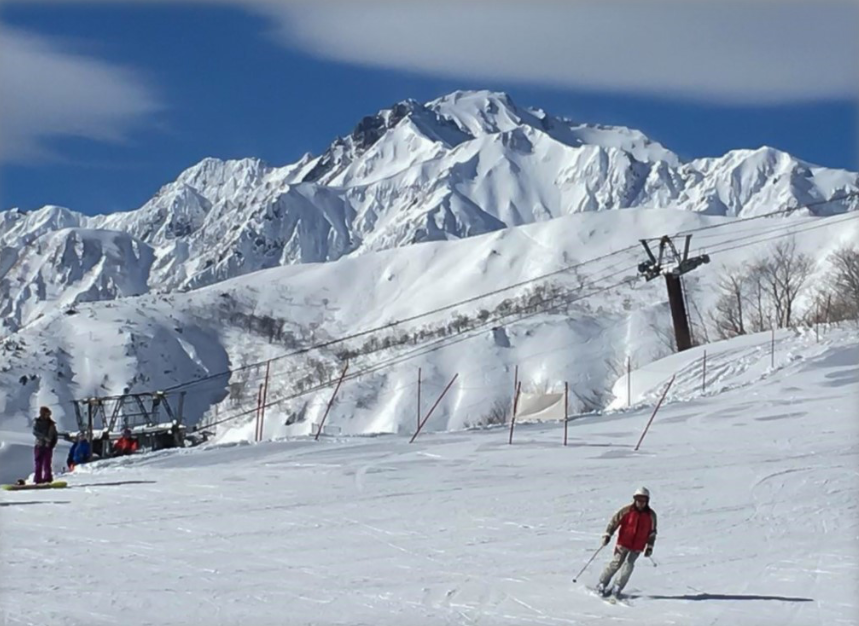
A final favorite area was Tsugaike. This area had many beginner runs at the bottom, and intermediate runs at the top where the elevation was 5591’, and a vertical drop of 2966’. It even had a Japanese Burger King at the base of the mountain.
A couple interesting facts about the ski areas. Each operates separately, with separate busses. The areas are leased from groups of farm families who owned the land for many years. Money has not been put into the lifts since the upgrades for the Olympics; they are maintained but are not the high speed, high tech lifts we’ve seen at ski areas in the US and Canada. The chair lifts are much lower to the ground than we were used to. We had broken boot warmers from the lift hitting them and many falls getting off the lift from our tall snowboarder. The backs of the char lifts are also much lower than we were used to.
The favorite ski day to remember ski varied amongst our travelers. A group of powder/tree hounds loved the two days at two separate mountains where they skied with Hannah, from Ski Japan; she took them early onto the mountains to find the best powder and trees areas before the crowds arrived.
Everyone enjoyed the blue bird days when we could see the mountains and surrounding areas much better. Our senior skier, Bill (who was 82) said he enjoyed Wednesday the best. That was a blue bird day he skied with 3 adventurous women who were 10 and 20 years younger than he. Bill had no trouble keeping up which inspired us all!
The good news ending to the ski report is that no one got hurt.
Non-ski activities
The overriding favorite activity for people who didn’t ski or who had taken a day off, was the Kimono Tea Ceremony. The ladies donned traditional kimonos which took 45 minutes each to assemble and dress with the help of a ‘grandmotherly type’ Japanese woman. She explained the history of the fabric, the process for dressing, and when the elaborate gowns are worn. Hair was pinned up too before the traditional Japanese tea ceremony and lunch began.
The whole group took a day tour to the Nagano Snow Monkey park on Thursday. The snow monkeys are an Old World monkey species that is native to Japan. They live the Joshinetsu Kogen National Park with their own primate-only onsen. (people onsens are described below) There were 160 monkeys in the clan in this park. Typically, they are very active, enjoy the snow and get into a trance-like state when enjoying their man-made hot tub experience in very cold weather. The day we visited it was raining and a bit warm so they weren’t gathering in the onsen too much, but rather dig- ging in the snow for food. We saw little small monkey’s enjoying swinging from low branches and be- ing quite playful.
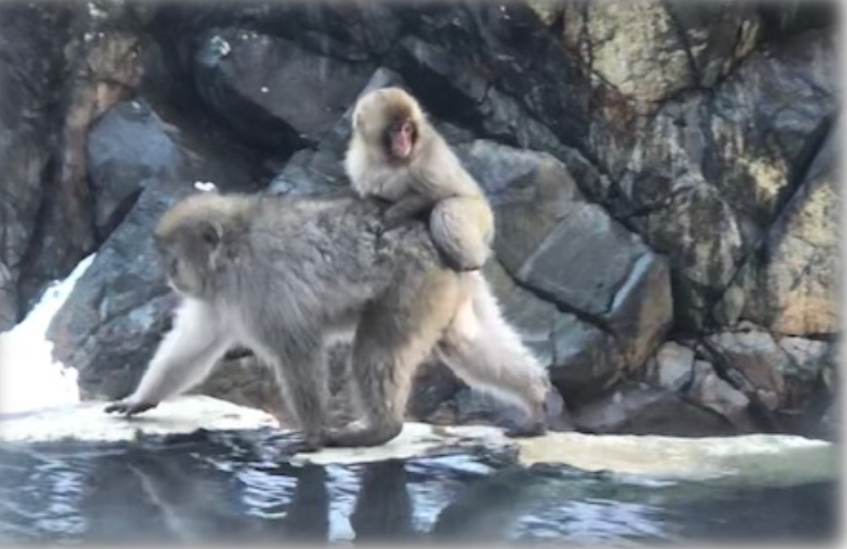
The snow monkey tour was followed by a visit to the Zenkogi Temple. The legend says that Zenkoji’s golden triad was the first Buddhist image to arrive in Japan from India over 1400 years ago. The image became the object of dispute between two feuding clans and was dumped into a canal. Later rescued from the canal, the Buddha statue was enshrined and the temple was built. The actual image is never shown, but every seventh year “the Sacred Replica” is displayed in a grand ceremony.
The tour concluded with a traditional Japanese lunch and walking around Obuse a very cute area in Nagano. Obuse provided opportunities for shop- ping, sake tasting and some ice cream with unique flavors of Miso Carmel, and Chestnut.
After a brief rest at the hotel, we ended the day with a dinner and Drummer show. The performers allowed the ski group members a couple sessions where we could perform our own drumming routine. Those were some loud drums!!
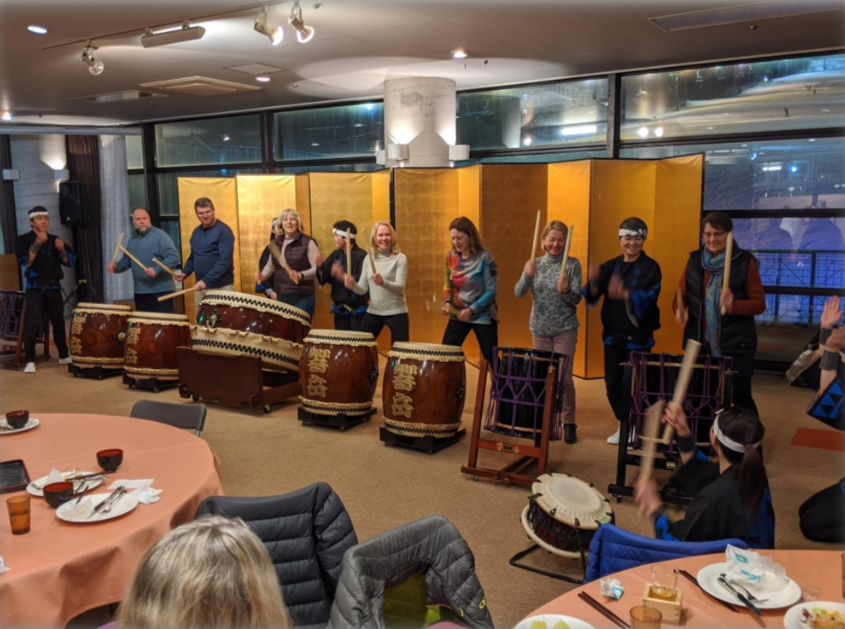
Several people went on a private tour to the Matsumoto Castle and a Wasabi Farm one day. Another group took a Japanese cooking class on another day. I heard good reports and fun experiences from all.
Japanese Onsen
In Japan, the onsen is a communal bathing facility which can be a bit intimidating. The onsen is segregated for males and females and bathing is done in the nude. Typically, you shower and cleanse yourself in a common area before immersing into this mineral hot bath with others. Our hotel in Hakuba had an onsen which many of us experienced. The inside onsen was extremely hot and the outside one was much more temperate. Typically, there is not supposed to be talking while relaxing in the onsen. Let’s just say this was not your typical ski area hot tub; absolutely no drinking in the on- sen, or loud reminiscing of your ski day!
Judi sent us a YouTube video about the onsen experience before our trip to get everyone ready. Those that used it found the onsen quite relaxing, and the mineral water relaxing to tired muscles.
Food
What to expect from the food? The Hakuba Mominoki Hotel provided breakfast and dinner buffets each day. The food was a combination of American and European cuisine, with a sprinkle of Japanese. You’d see eggs, cereals, bread and fruit, as well as salads and meats and cheeses. On top of that, there would be miso and vegetable soups, and a bit of curry for breakfast. It was all sort of brunch like.
For dinner, we saw grilled fish and meat, pasta, salad, soups and desserts. There was lots of seafood and pork; very little chicken or beef beyond a steak at the grill. The food was less typical Japanese than we were expecting at the hotel.
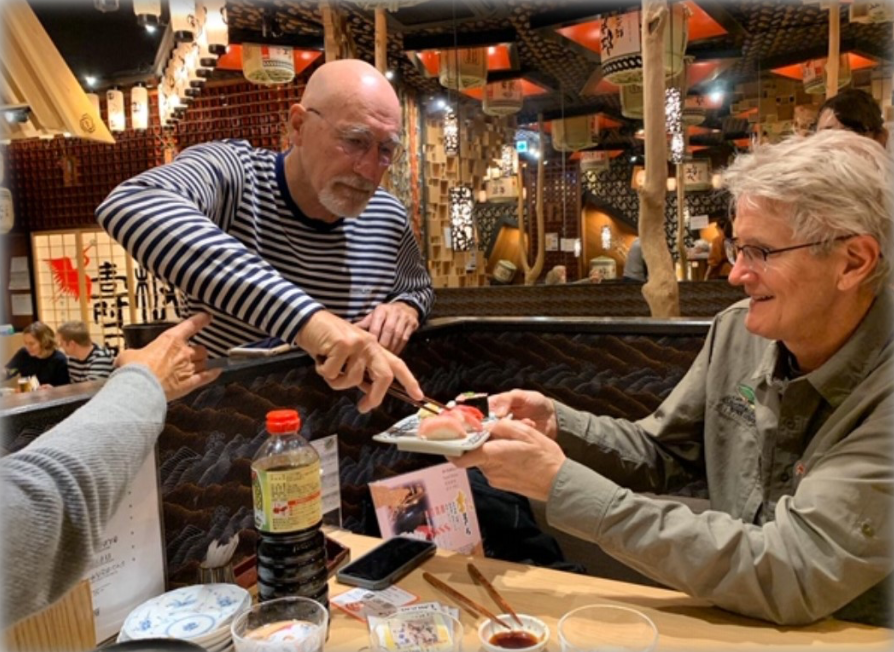
On the mountain, the cafeterias generally had a variety of noodle bowls and curry dishes. You would order by number or on a machine, and wait for your number to come up. This helped the language barrier. You do not see the typical chili, soups or hamburgers at these ski areas. I did find a pizza one time so was excited for that change of pace after so much rice during the week.
As I mentioned earlier, Tsugaike had a Japanese Burger King at the base of the mountain. We saw a McDonald’s at the Tokyo airport and learned that there isn’t much beef in any of the burgers; they are primarily pork based.
Tokyo
After our week of skiing, we took the bullet train from Nagano into Tokyo. The bullet train ride was approximately 90 minutes and traveled about 160 mph.
Our larger luggage was shipped back to the airport from the Hakuba Mominoki Hotel the day before. We were only allowed to take our carry-on suitcases on the bullet train. Black Cat luggage service held our luggage until we flew out so we didn’t need to fuss with it in Tokyo.
We were met at the train station with a bus and tour guide who gave us about 4 hour tour of Tokyo. Tokyo has over 13 million people. We visited the Meiji Shrine and the Asakusa Temple. Shrines are based on the Shinto religion which has no founder or scripture. Temples support Buddhism from the 6th century.
An interesting perspective on Japan shared by our tour guide, Japan has:
- 55,000 convenience stores
- 57,000 drug stores
- 77,000 temples
- 81,000 shrines
- 2.5 million vending machines
After the bus tour, we checked into the Akasaka Excel Hotel Tokyu. This hotel was much higher end than we see in typical ski towns while on ski club trips. It had 10 restaurants, lots of shopping, and was across from a train station entrance. It was also about a block from a street full of typical Japanese restaurants and lots of sushi. The hotel provided a daily breakfast buffet. One unique item on that buffet was curried fish guts….let’s say that most of us did not try that one.
On our last full day in Tokyo, people did several things. Some had friends who they met for private tours and dining. Several in the group went on a walking tour lead by the tour guide from the bus tour the day before. The guide took us to Hie Shrine, the Akasaka Palace and the Ginza Shop- pingDistrict. And a few explorers ventured out on their own.
Monday was our travel day home. The bus back to Tokyo-Narita airport was about an hour from the hotel. Before we left in the early afternoon, we had time for some last touring and a final Japanese lunch. Several toured places like the Tsukiji fish market, Scramble Square and Shibuya Sky Tower. Everyone felt good about mastering the train system to get around the city. A final visit at the 2020 Tokyo Olympics store provides souvenirs for those that hadn’t collected some along the way.
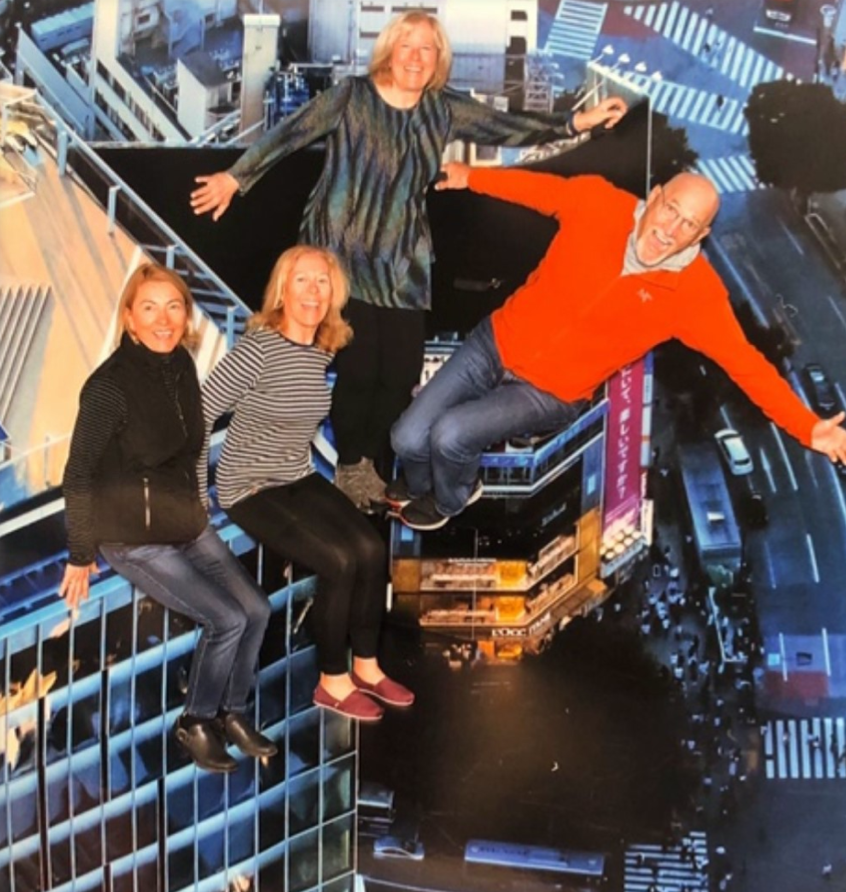
We left Tokyo at 5:50 pm local Tokyo time on Monday and arrived in Atlanta about 4:00 pm ET the same day, thanks to the 14 hour time difference. We were back in Cleveland about 9:30 pm and anxious to get home and to our own beds after a very fun, action packed journey to the far east.
And no injuries were reported in Tokyo either!